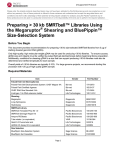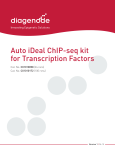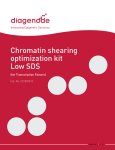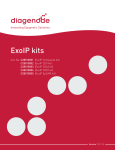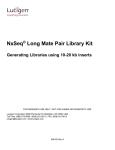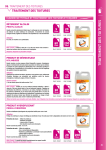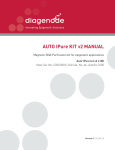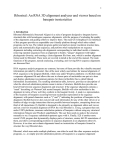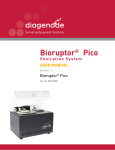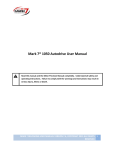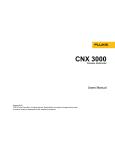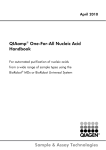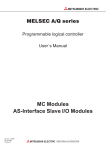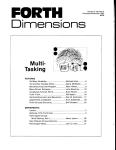Download - Diagenode
Transcript
Megaruptor ® DNA Shearing System USER MANUAL Ve rs i o n 2 Megaruptor® Cat. No. B06010001 Version 2 I 03.2015 Guarantee Limited one year global warranty Diagenode guarantees all products from any manufacturing defects as we rigorously test all products to meet strict quality standards. Diagenode warrants that all standard components of its instruments will be free of defects in materials and workmanship for a period of one (1) year from the date that the warranty period begins, unless the original quotation or accompanying documentation states a different warranty period. All warranty periods begin on the date of delivery and apply only to the first purchaser of the product. If a manufacturing defect arises and a valid claim is received within the warranty period, Diagenode, at its discretion, will repair or replace the product in accordance with the warranty terms and conditions stated herein. In case of repair or replacement of a product under warranty, Diagenode will cover the expenses to return the repaired or replacement product. This warranty covers only manufacturing defects and does not cover any damage caused by misuse, lack of compliance to recommendations stated in the manual, neglect, accidents, abrasion, or exposure to extreme temperatures, chemical solvents, or acids. We strongly recommend that maintenance or repairs of Diagenode’s products are performed by our approved Diagenode service center. Improper or incorrectly performed maintenance or repairs will void the warranty. Technical Assistance & Ordering Information Diagenode s.a. BELGIUM | EUROPE LIEGE SCIENCE PARK Rue Bois Saint-Jean, 3 4102 Seraing - Belgium Tel: +32 4 364 20 50 Fax: +32 4 364 20 51 [email protected] [email protected] Diagenode Inc. USA | NORTH AMERICA 400 Morris Avenue, Suite #101 Denville, NJ 07834 - USA Tel: +1 862 209-4680 Fax: +1 862 209-4681 [email protected] [email protected] For a complete listing of Diagenode’s international distributors, visit: http://www.diagenode.com/en/support/distributors.php For the rest of the world, please contact Diagenode s.a. DIAGENODE MEGARUPTOR® USER MANUAL PAGE 3 Content General Information About the Megaruptor® from Diagenode 4 System Performance 5 Megaruptor® Technical Specifications 5 Installing Your System 7 Processing Samples 9 Troubleshooting FAQ 15 Maintenance 16 Installing a Syringe 18 Ordering Information Back Cover Diagenode Inc. North America / Phone: +1 862 209-4680 // Fax: +1 862 209-4681 // Mail: [email protected] PAGE 4 DIAGENODE MEGARUPTOR® USER MANUAL General Information About the Megaruptor® from Diagenode Congratulations on your purchase of the Megaruptor® from Diagenode. The Megaruptor® was designed to provide researchers with a simple, automated, and reproducible device for the fragmentation of DNA in the range of 2 kb - 75 kb. Shearing performance is independent of the source, concentration, temperature, or salt content of a DNA sample. Our user-friendly software allows for two samples to be processed sequentially without additional user input and without cross-contamination. Just set the desired parameters and the automated system takes care of the rest. Clogging issues are eliminated in this design. System Configuration and Components The Megaruptor® base unit consists of an automated syringe pump with attached 9-port ceramic distribution valve and an integrated power supply. In order to control the device, a laptop with pre-loaded software is provided. An RS-232 cable and USB-to-serial adapter are supplied for communication, and a power cord is included to provide power to the base unit. A 1mL syringe is provided. In order to fragment DNA, shearing devices (Hydropores) must be attached to the valve. Site Requirements The Megaruptor® requires access to a grounded 110V or 220V wall outlet. Different power cords are offered depending on your region. The female end of each power cord is identical and plugs into the power-input socket at the rear of the base unit. The male end of each power cord is different. You should have been supplied with a power cord suitable for the wall socket in your country or region. While the base unit has a small footprint, be sure to clear sufficient bench space to also accommodate the laptop and wash buffers. The unit is designed for operating temperatures between 59° F (15° C) and 104° F (40° C), operating humidity between 20% and 80% relative humidity at 104° F, and storage temperatures between -4° F (20° C) and 149° F (65° C). Do not store, ship, or operate the device under conditions where temperature fluctuations could cause condensation within the unit. Contact Information Please contact Diagenode with any questions, comments, general feedback, or for technical support. Diagenode s.a. BELGIUM | EUROPE Diagenode Inc. USA | NORTH AMERICA LIEGE SCIENCE PARK Rue Bois Saint-Jean, 3 4102 Seraing - Belgium Tel: +32 4 364 20 50 Fax: +32 4 364 20 51 [email protected] [email protected] 400 Morris Avenue, Suite #101 Denville, NJ 07834 - USA Tel: +1 862 209-4680 Fax: +1 862 209-4681 [email protected] [email protected] Europe Diagenode sa / LIEGE SCIENCE PARK // Rue Bois Saint-Jean, 3 // 4102 Seraing (Ougrée) // Belgium // Phone: (+32) 4 364 20 50 // Mail: [email protected] DIAGENODE MEGARUPTOR® USER MANUAL PAGE 5 System Performance Principle The Megaruptor® uses the principle of mechanical shearing to fragment DNA. As DNA in solution is pumped through a Hydropore shearing device, it passes through an array of uniform pores. The resulting turbulent flow stretches and breaks the DNA strands. The length of the resulting fragments is dependent on the fluid flow rate and the size of the pores. Passage of the DNA molecules several times through the pores ensures that they will reach a minimum and uniform length as compared to a single pass through the Hydropore. Fragment Length Range Two Hydropore shearing devices are available for use with the Megaruptor®. They each produce narrow distributions of fragments with the majority of molecules lying within a 2 to 3- fold size distribution. The Short Fragment Hydropore is capable of producing fragments with mean length of between 2 kb and 9 kb, while the Large Fragment Hydropore can produce fragments with mean length between 10 kb and 75 kb. The user-friendly software requires the operator to specify just three parameters: the number of samples, the volume of each sample, and desired mean fragment sizes. The Megaruptor® translates this information into the appropriate operating conditions and processes the samples automatically. Megaruptor® Technical Specifications Megaruptor® Power Supply Transformer 220V/110V 24V, 3A (Internal) Internal Main Unit Dimenions 67(W) x 218(D) x 255(H) mm Base dimensions (footprint) 125(W) x 185(D) x 12(H) mm Fragment Length Range Achievable Sample Volumes Accepted Sample Concentration Tubes Throughput Time per sample Total weight Control Software 2 kb - 75 kb Minimum: 50 µl. Maximum: 400 µl (depending on fragment length; see “Processing Samples” chapter) Recommended: 200 µl 0 - 50 ng/µl recommended: 25 ng/µl 0.5 mL free-standing, provided Two samples processed in series 10 - 20 min (depending on target size); includes sample processing and system washing 8 kg Windows compatible, pre-installed on included laptop Diagenode Inc. North America / Phone: +1 862 209-4680 // Fax: +1 862 209-4681 // Mail: [email protected] PAGE 6 DIAGENODE MEGARUPTOR® USER MANUAL Short fragment size range A 1 2 3 4 5 Reproducible and narrow DNA size distribution with Megaruptor ® using short fragment size Hydropores Validation using two different DNA sources and two different methods of analysis. Figure A: Shearing of lambda phage genomic DNA (20 ng/µl; 150 µl/sample) sheared at different speed settings and analyzed on 1% agarose gel. B Lane 1 2 3 4 5 Target length 2 kb 3 kb 4 kb 6 kb 1 kb + ladder 2 kb 3 kb 5 kb Figure B: Fragment Analyzer profiles of human genomic DNA (25 ng/µl; 200 µl/sample) sheared at different software settings of 2, 3, 5 and 8 kb. (Standard Sensitivity Large Fragment Analysis Kit, DNF-492; Advanced Analytical Technologies, Inc. was used for separation and fragment sizing). 8 kb Large fragment size range 13 kb 20 kb 25 kb 40 kb Demonstrated shearing to fragment sizes between 13 kb and 40 kb with Megaruptor ® using long fragment size Hydropores 49 kb 40 kb Image shows DNA size distribution of human genomic DNA sheared with long fragment Hydropores using software settings of 13, 20, 25 and 40 kb. Two independent experiments were run for each setting. DNA was analyzed by pulsed field gel electrophoresis (PFGE) in 1% agarose gel. 25 kb 15 kb 10 kb 8 kb 6 kb 5 kb 4 kb Europe Diagenode sa / LIEGE SCIENCE PARK // Rue Bois Saint-Jean, 3 // 4102 Seraing (Ougrée) // Belgium // Phone: (+32) 4 364 20 50 // Mail: [email protected] DIAGENODE MEGARUPTOR® USER MANUAL PAGE 7 Installing Your System Delivery Checklist Ensure that all parts and materials have been delivered. Please report missing or damaged parts to your local sales representative. Delivery Checklist for Megaruptor® Description Quantity Laptop with installed software 1 USB-to-serial cable 1 Power cable 1 Base unit (syringe pump with valve) 1 System manual 1 1 mL syringe , pre-installed 1 Bottles 5 Hydropore shearing devices 20 pieces of: • short (2 - 9 kb fragment length) or • long (10 - 75 kb fragment length) Hydro Tubes 50 pc Required reagents not supplied • 0.5 M NaOH • 0.5 M HCl • H2O • TE or EB buffer Note: All reagents should be of molecular grade. It is highly recommended to filter all solutions through a 0.22 µm PES filter. (Pall Life Sciences AVFP02M or Corning EK-680502) Connections and Communication 1. Connect the USB end of the communications cable to the laptop and the other end to the male serial port on the base unit. Secure this connection using the screws on the cable. 2. Plug the female end of the power cord into the AC power receptacle at the back of the base unit. Plug the 3-prong male end into a grounded wall outlet. Reagent Set-Up The base unit of the Megaruptor® contains a ceramic valve with 9 ports in one rows for the automation of shearing and washing steps. The ports are numbered in a clockwise fashion, starting with the far left port, as illustrated below in Figure 3. It is imperative that the wash reagents (not supplied) and samples are connected to the correct ports on the valve. The default set-up is as follows: Diagenode Inc. North America / Phone: +1 862 209-4680 // Fax: +1 862 209-4681 // Mail: [email protected] PAGE 8 DIAGENODE MEGARUPTOR® USER MANUAL Figure 3. Orientation of ports on the ceramic valve. 4 5 Port 1: S ample 1. See the section on Processing Samples for instructions on preparing the sample for shearing and setting the shearing parameters in the software. 6 3 Port 2: Unused. Plug this port with one of the provided nuts to prevent dust or particulates from entering the valve. 7 2 Port 3: Air. Attach the short “looped” length of tubing labeled “Air” to Port 3. 8 1 9 Port 4: Waste. Attach the length of tubing labeled “Waste” to Port 4. Place the end of the tubing into a waste receptacle with volume at least 100 mL. Port 5: HCl. Attach the length of tubing labeled “HCl” to Port 5. Place the end of the tubing into a reservoir of 0.5 M HCl. It is recommended that all wash solutions are filtered to 0.22 μm before use. Note: Do NOT place the bottle of HCl or any other wash solution at a higher elevation than the pump itself. Hydrostatic pressure can force the acid into the valve, leading to destruction of the DNA sample. 1 9 Port 6: N aOH. Attach the length of tubing labeled “NaOH” to Port 6. Place the end of the tubing into a reservoir of 0.5 M NaOH. It is recommended that all wash solutions are filtered to 0.22 μm before use. Note: Do NOT place the bottle of NaOH or any other wash solution at a higher elevation than the pump itself. Hydrostatic pressure can force the base into the valve, denaturing the DNA sample. Port 7: H2O. Attach the length of tubing labeled “H2O” to Port 7. Place the end of the tubing into a reservoir of H2O. It is recommended that all wash solutions are filtered to 0.22 μm before use. Note: Do NOT place the bottle of H2O or any other wash solution at a higher elevation than the pump itself. Port 8: TE Buffer. Attach the length of tubing labeled “TE” to Port 8. Place the end of the tubing into a reservoir of 10 mM TE Buffer. If it is imperative that EDTA is not introduced into the sample, the TE buffer can be substituted with 10 mM Tris-Cl, pH 7.5. It is recommended that all wash solutions are filtered to 0.22 μm before use. Note: Do NOT place the bottle of TE or any other wash solution at a higher elevation than the pump itself. Port 9: Sample 2. See the section on Processing Samples for instructions on preparing the sample for shearing and setting the shearing parameters in the software. Note: When choosing the volume of wash reagent to prepare, be advised that washing after each sample will consume approximately 1.5 mL of HCl, NaOH, and H2O, and approximately 4 mL of TE. For most labs, the 250 ml bottles which have been supplied should be adequate of each solution. All bottles have to be placed on the same elevation as the Megaruptor. Europe Diagenode sa / LIEGE SCIENCE PARK // Rue Bois Saint-Jean, 3 // 4102 Seraing (Ougrée) // Belgium // Phone: (+32) 4 364 20 50 // Mail: [email protected] DIAGENODE MEGARUPTOR® USER MANUAL PAGE 9 Processing Samples Sample Preparation While the design of the Hydropore enables the Megaruptor® to fragment DNA without the clogging problems encountered in single-orifice devices, it is still important that the sample be pure DNA at a reasonably low concentration. These guidelines will assist the user in preparing a sample that will be quickly and easily sheared with the Megaruptor®. Take care that the sample is free of protein or other cellular debris. The fragmentation performance is largely independent of standard buffer components and is tolerant of a wide range of salt concentrations and pH. However, often during the purification process and particularly with plant sources, detergents such as SDS, CTAB, or Skarkosyl are used. If detergent is present during the shearing process, the sample will become frothy. The presence of air in the sample, as well as the unexpected increase in sample volume, will both be detrimental to the shearing performance. If any detergent or suspended particles are visible in the sample, it is best to centrifuge to remove these impurities from the DNA in solution in order to avoid clogging the Hydropore. Spin the samples at room temperature for 15 minutes at 16,000 x g. Remove the supernatant containing the DNA sample, leaving the pellet undisturbed. If it is possible that the DNA itself has precipitated, use whatever heating or stirring measures necessary to dissolve the nucleic acids prior to spinning down so that the DNA is not lost. In principle, the Megaruptor® is capable of shearing DNA solutions regardless of the DNA concentration. However, the viscosity of fluids containing high concentrations of DNA, particularly very high molecular weight genomic DNA, can make the process problematic. Highly viscous fluid will move through the tubing and Hydropore more slowly than solutions with lower concentrations of DNA. This makes the fluid flow unpredictable and difficult to efficiently automate. Highly concentrated genomic DNA also has a tendency to aggregate and clump. This can be attenuated by mixing the sample via rapid pipetting. Diagenode recommends that the concentration of DNA be no greater than 50 μg/mL for optimal performance. Samples with concentration greater than 50 μg/mL may need to be processed several times before the entire sample is fragmented to the desired length. Diagenode suggests that high concentration samples be diluted in TE buffer down to 50 μg/mL prior to processing. Additionally, the viscosity of DNA solutions containing very high molecular weight genomic DNA can be slightly reduced by rapidly pipetting the sample to begin the fragmentation process before submitting the sample to the Megaruptor®. The Megaruptor® is designed to process sample volumes between 50 ul and 400 ul. It is recommended to use a minimum sample volume of 100 - 250 μl for 2 kb fragments. If the sample volume exceeds this range after dilution, it can be split into two or more aliquots for shearing. In this case, a new Hydropore is not necessary. Simply reuse the same Hydropore for each subsequent aliquot of the same sample. The number of times a Hydropore can be reused depends on the purity of the sample being sheared. Shearing small volume samples (<75 μl) at high speeds (targeting fragment sizes 2 kb) can lead to larger-than-expected fragments. This is likely due to small bubbles decreasing the effective flow rate, and the pump having difficulty accelerating to the required speed over very short stroke lengths. The unexpected increase in fragment length is typically not more than 300 bp, but the user should be aware of this possibility. Diagenode Inc. North America / Phone: +1 862 209-4680 // Fax: +1 862 209-4681 // Mail: [email protected] PAGE 10 DIAGENODE MEGARUPTOR® USER MANUAL Software Operation Opening the Software A laptop computer is provided with the Megaruptor®, and the software and all drivers are already loaded. Simply open the “Megaruptor®” program by double-clicking the icon on the desktop or from the Start Menu by navigating to Start – Diagenode – Megaruptor®. The Home tab will now be displayed. Select COM port The first time the program is run, the correct COM port must be selected. The COM port in use will depend on which USB port the pump is connected to. Before pressing any buttons on the panel, use the drop-down menu beneath the “Initialize Pump” button and select “Refresh”. A list of active COM ports will be available – if none of the other USB ports are in use, there should be only one. Select this COM port. Then navigate to the Menu bar in the top left corner and select “Communications – Set COM port”. The software will now remember this COM port, so it is not necessary to select it manually each time the program is opened. Initialize The pump must be initialized each time it is turned on. If the pump has been left on since its last use, it is not necessary to re-initialize even if the software was exited. The pump must be re-initialized each time a new syringe is installed. Click the “Initialize Pump” button. The syringe plunger will move down briefly and then back up until it hits the valve. This sets the syringe to its “0” position. A dialog box indicating “Initialization Sequence Complete” will appear. Click “OK”. If you do not observe the pump movements, you do not get a confirmation, or you receive an error, the computer is not communicating properly with the pump. Check to make sure that the pump is turned on, the USB to serial cable is securely attached to both the computer and the pump, and that the correct COM port has been selected. Europe Diagenode sa / LIEGE SCIENCE PARK // Rue Bois Saint-Jean, 3 // 4102 Seraing (Ougrée) // Belgium // Phone: (+32) 4 364 20 50 // Mail: [email protected] DIAGENODE MEGARUPTOR® USER MANUAL PAGE 11 Wash The syringe and valve must be thoroughly washed and rinsed between each sample. While the software will automatically wash the pump after each sample is processed, it is advisable to also wash the system before the first sample is sheared. Click the “Wash Syringe” button. The pump will automatically rinse the syringe and valve with four solutions in order to eliminate any potential crossover contamination from DNA in the previous sample. First, 0.5 M HCl is used to depurinate the DNA, eliminating the purines from the DNA strand and also causing DNA strand breakage. Next 0.5 M NaOH is introduced to denature the DNA. Following the NaOH wash, any residual DNA will be short single-stranded fragments of pyrimidines. These are washed away with several rinses with water, before a series of washes with TE buffer make the syringe and valve DNA-friendly and ready for the next sample. The wash sequence progress is indicated by the green LEDs below the “Wash Syringe” button. The “Stop” button can be used to interrupt the wash sequence at any time. However, this is not recommended, as prematurely stopping the wash cycle may leave HCl or NaOH in the syringe and valve, causing the destruction of any DNA sample introduced at a later time. If the wash cycle must be stopped, it is recommended that a subsequent full wash be completed before processing any samples. Note: If the “TE rinse” option has been selected (See the section on Full Manual Operation), an abbreviated Wash protocol will be used and the green LEDs are not used to indicate progress. Select Number of Samples The Megaruptor® can process two samples consecutively without additional user input. Enter the number of samples now. Next, click on the “Sample Parameters” tab to reach the page where the software asks for some information about the samples. Enter Parameters For each sample, enter the volume of the DNA solution. See the section on Sample Preparation when deciding what sample volume and concentration to use. Next, choose the mean fragment size that is desired for each sample. When using the Short Fragment Hydropore, the drop-down menu will contain a range of choices between 2 kb and 9 kb. If the Large Fragment Hydropore is selected, the user can select from mean fragment sizes of 10 kb - 75 kb. Use the toggle switch to alternate between the Short and Long fragment length options, then use the drop-down menu to select the fragment size of interest. Diagenode Inc. North America / Phone: +1 862 209-4680 // Fax: +1 862 209-4681 // Mail: [email protected] PAGE 12 DIAGENODE MEGARUPTOR® USER MANUAL Pre-Load Hydropores If the “Pre-Load Hydropore” option is set as “ON”, the Hydropores will be “primed” with TE buffer. This minimizes the air in the system, leading to decreased sample splashing and more consistent results. By default, this switch is ON, and we recommend pre-loading for every sample where dilution is not a serious concern. Note: This procedure will dilute your sample by 45 µl. Click the “Pre-Load Hydropores” button. A prompt appears for the user to attach Hydropores to appropriate ports on the valve. Note: For this step, it is very important that the Hydropores are securely threaded into the valve but the samples are NOT attached to the Hydropores! After attaching the Hydropores, click “OK”. The pump will prime the Hydropores with TE buffer. Move to the “Process Samples” tab. Figure 5. Gently press the sample tube into the “lid” of the Hydropore. It should be held securely. It may be helpful to remove the attached tube cap. The tip of the tubing can be about 1 mm from the bottom of the tube and the entirety of the sample will still be drawn into the syringe. Use Figure 5 as a guide when positioning the Hydropore in the sample tube. Europe Diagenode sa / LIEGE SCIENCE PARK // Rue Bois Saint-Jean, 3 // 4102 Seraing (Ougrée) // Belgium // Phone: (+32) 4 364 20 50 // Mail: [email protected] DIAGENODE MEGARUPTOR® USER MANUAL PAGE 13 Monitor Progress When the samples are secured in their proper positions, click “Start” to begin the shearing sequence. The “Instrument Status” text box will indicate the status of each sample. Additionally, progress bars are provided to help monitor the shearing. When using very long genomic DNA, the DNA solution can be quite viscous. Pumping viscous DNA at high speeds does not lead to optimal performance. Thereby, by default, when the user selects a mean fragment size of 5 kb or smaller, the DNA is first sheared at a lower speed before the normal shear cycle begins. This starts to break up the DNA so that the solution is less viscous. This is called the “Pre-Shear”. Thus, the steps involved in the processing of each sample are as follows: 1. S ample Load – The sample is slowly drawn into the syringe and then ejected back into the sample tube 3 times. This serves to mix the sample with the TE in the Hydropore and helps to eliminate any air trapped in the fluid path. 2. P re-Shear (less than 5 kb) – The sample is cycled through the Hydropore seven times at a slow flow rate. The progress bar will indicate how many cycles have been completed. 3. S hear – The sample is cycled through the Hydropore 15 times at a speed that is determined by the desired final fragment length. Shorter fragment lengths require the sample to be pumped at higher flow rates. The progress bar will indicate how many cycles have been completed. 4. S ample Recovery – At the conclusion of the shear step, some of the sample will be left in the tubing attached to the Hydropore. In order to recover this portion of the sample, the syringe will draw in air and expel it through the shearing device tubing. When this step is complete, the sample has been fully processed and can be removed for downstream reactions. 5. W ash – The pump will now wash the syringe and valve as described in the “Wash” section to ready the device for the next sample. The “Stop” button may be used to interrupt a shear in progress. This will immediately stop all pump movements. Note that when the Stop button is used, it is not possible to resume the program from the point at which it was stopped. The entire shearing process must be restarted. The “Pause” button allows the user to temporarily halt the program. When the Pause button is used, the pump will finish its current movement before stopping. Clicking the Pause button again will allow the program to continue operating from the point at which it was halted. Full Manual Operation Manual operation mode can also be useful to contend with any unexpected problems that may occur during the shearing runs. For simple operations, two tools are provided. These can be useful when performing additional maintenance steps. The “Aspirate” and “Dispense” buttons allow the user to draw in or expel fluid from the syringe. Just specify the desired volume and press the appropriate button. “Move to Port” allows the user to select the input/output port by entering a number between 1 and 9. Another useful feature is the “Recover Sample” button. This can be used in the event that the shearing run had to be stopped unexpectedly, or the communication between the computer and pump failed causing the software to freeze. If there is ever a problem with the software or shearing run, and it is desirable to recover the sample, it is very important that the pump is not turned off! The computer and software can be restarted as necessary, but losing power to the pump will cause the loss of the sample. Simply re-open the software, select the number of the sample to be recovered, and push the Recover button. This will eject the sample back into the tube, and then use air to clear the Hydropore tubing. Wait for the pump to stop moving before removing the sample tube from the Hydropore. When the same DNA sample is being sheared in several different aliquots sequentially, a full wash cycle may not be necessary between each shearing run. In this case it may be economical to save time and reagent by using an abbreviated Diagenode Inc. North America / Phone: +1 862 209-4680 // Fax: +1 862 209-4681 // Mail: [email protected] PAGE 14 DIAGENODE MEGARUPTOR® USER MANUAL wash protocol. The Wash Sequence switch can be toggled between “Full Wash” and “TE Buffer Rinse”. By default it is set for “Full Wash”, and the syringe is automatically washed with HCL, NaOH, H2O, and TE buffer. If the switch is set to “TE Buffer Rinse”, the acid and base washes are skipped, and a brief rinse with water and TE buffer is used. In this case the syringe is NOT de-contaminated, and this should ONLY be used when the same DNA sample is being sheared several times. Note that toggling this switch will affect all wash sequences, including the one initiated by the “Wash Syringe” button on the Home tab and the automatic washes that are conducted between the samples. Be sure to set the switch back to “Full Wash” when a new DNA sample is introduced to the system. For more advanced troubleshooting, a section is included to send raw commands to the pump. To take full advantage of this feature the user will need to become acquainted with the commands and syntax that control the unit. Text lines can be entered into the “Input Commands” boxes and then sent to the pump. When the “Run Commands” button is pressed, all lines of code in the box will be sent to the pump. See Appendix A for assistance with syntax. When technical support is required, a Diagenode representative may guide the user and provide lines of code to be entered here. Europe Diagenode sa / LIEGE SCIENCE PARK // Rue Bois Saint-Jean, 3 // 4102 Seraing (Ougrée) // Belgium // Phone: (+32) 4 364 20 50 // Mail: [email protected] DIAGENODE MEGARUPTOR® USER MANUAL PAGE 15 Troubleshooting FAQ Q: The volume of DNA sample appears to be decreasing. A: Look for signs of wetness or dripping at the connections between the syringe and valve and between the Hydropore and valve. Check and tighten all fluidic connections. Check to see if the sample has splashed up onto the walls of the sample tube. If it has press pause. Remove the tube from the Hydropore. Tap the tube to make the drops slide back to the bottom of the tube. Q: How are the volume and concentration of the sample affected by the shearing process? A: I f the “Pre-load Hydropore” box in the Setup Device tab is checked, as is recommended and is the default, each sample will be diluted by about 45 μl of TE. Q: Bubbles are visible in the syringe during shearing. A: It is normal for small bubbles to appear when the pump is aspirating the sample into the syringe. These bubbles typically cling to the walls of the syringe or to the Teflon seal on the plunger. When the plunger has completed its downward movement, the pressure in the syringe will equilibrate and the bubbles should decrease in size and be barely visible. They will be further compressed when the fluid is ejected out of the syringe. These small bubbles do not affect shearing performance. If larger bubbles are present in the syringe and they do not disappear when the aspiration step is completed, it is possible that shearing performance will be affected. Typically this is caused by a dirty syringe or loose connections. Check and tighten all fluidic connections. Perform a syringe wash. If more stringent washing is required, follow the manufacturer’s advice on maintaining the syringe as described in chapter: Maintenance. If none of these measures are successful the seal on the syringe may have been compromised and the syringe should be replaced. Q: During the sample load step and subsequent shearing steps, the sample is not being fully drawn into the syringe. A: T his is most likely caused by a sample with DNA concentration in excess of 50 μg/mL. The sample is too viscous to be drawn into the syringe in the time allotted. In some cases, shearing a sample with very high concentration multiple times will result in satisfactory performance. However, Diagenode recommends diluting samples to 50 μg/mL. This may also be due to a dirty or contaminated sample causing the Hydropore to clog. A sample with many suspended particles, proteins, or cellular debris can clog the Hydropore. See the section on “Sample Preparation” for guidelines. Q: The DNA fragments are not the expected size. A: T he software is calibrated to consistently provide reproducible results regardless of sample conditions. One exception is shearing small volumes (less than 75 μl) at high speeds (2 kb). Whether it is due to small bubbles having a greater effect on small volumes, or the pump being unable to achieve high speeds over short distances, it has been observed that the mean size of the resulting fragments can be up to 300 bp larger than expected. Q: The shearing process was stopped mid-run. Is it possible to recover the sample that was being sheared? A: Yes, the Full Manual Operation tab provides a mechanism to deal with unforeseen complications such as this. TUse the Recover Sample button on the Full Manual Operation tab to push the sample out of the syringe and Hydropore tubing Q: The sample appears to have been lost/There is no DNA on the Bioanalyzer trace/There is no DNA on the agarose gel. A: The most likely cause is that the sample has been contaminated with HCl from the wash buffer. Check closely to make sure that each reagent line is connected to the correct port on the valve. Also verify that the reagent bottles are NOT placed at a higher elevation that the device itself. Diagenode Inc. North America / Phone: +1 862 209-4680 // Fax: +1 862 209-4681 // Mail: [email protected] PAGE 16 DIAGENODE MEGARUPTOR® USER MANUAL Maintenance While the pump is in regular use, additional maintenance steps are typically unnecessary. The syringe wash that is performed after each sample should sufficiently flush the fluid paths to keep them clean and clear. However, steps can be taken to optimize the performance and lifetime of the pump and syringe. Pump Maintenance The pump should regularly be inspected for leaks and any problems corrected. All spills on or around the pump should be cleaned up immediately. The pump should be flushed (draw fluid into and then expel) thoroughly with distilled or deionized water when not in use. Additional washes can be performed if the user suspects that the system requires more stringent washing. The pump manufacturer has provided washing regimens for three possible wash solutions: weak detergent, weak acid/base, and bleach. The use of the Full Manual Operation controls will be instrumental in the execution of these regimens. For example, to flush the pump with distilled water: • Ensure that the system is initialized. • Open the Full Manual Operation tab. • Set the Valve Position to 7 (by default, the H2O line). • Set the Aspirate volume to 1000 microliters and press the button. The plunger will move to the bottom of the syringe, drawing in water. • Set the Valve Position to 4 (the Waste line). • Set the Dispense volume to 1000 microliters and press the button. This will expel the water from the syringe and out into the waste container. • Repeat as necessary A similar protocol can be followed for the wash solutions. The wash solutions can be plugged into the unused port, Valve Port 2. Weak Detergent Cleaning To clean the pump with weak detergent (2% solution of CONTRAD 100 is recommended by manufacturer), follow these steps: 1. Prime (fill) the pump and syringe with a weak detergent solution. Allow the solution to remain in the pump with the syringe fully lowered for 30 minutes. 2. Expel the fluid from the syringe and pump into a waste container. 3. Flush the pump at least 10 times with distilled or deionized water. 4. Allow the water to remain in the fluid pathways for storage. Cleaning with Weak Acid and Base To clean the pump with weak acid and base, follow these steps: 1. Prime (fill) the pump and syringe with 0.1 N NaOH. Allow the solution to remain in the pump with the syringe fully lowered for 10 minutes. 2. Expel the fluid from the syringe and pump into a waste container. 3. Flush the pump with distilled or deionized water. 4. Prime (fill) the pump and syringe with 0.1 N HCl. Allow the solution to remain in the pump with the syringe fully lowered for 10 minutes. 5. Expel the fluid from the syringe and pump into a waste container. 6. Flush the pump at least 10 times with distilled or deionized water. 7. Allow the water to remain in the fluid pathways for storage. Europe Diagenode sa / LIEGE SCIENCE PARK // Rue Bois Saint-Jean, 3 // 4102 Seraing (Ougrée) // Belgium // Phone: (+32) 4 364 20 50 // Mail: [email protected] DIAGENODE MEGARUPTOR® USER MANUAL PAGE 17 Cleaning with 10% Bleach To clean the pump with bleach, follow these steps: 1. Make a solution fo 10% bleach by adding one part of commercial bleach to 9 parts of water. 2. Prime (fill) the pump and syringe with the 10% bleach. Allow the solution to remain in the pump with the syringe fully lowered for 30 minutes. 3. Expel the fluid from the syringe and pump into a waste container. 4. Flush the pump at least 10 times with distilled or deionized water. 5. Allow the water to remain in the fluid pathways for storage. Syringe Maintenance The following guidelines are provided by the syringe manufacturer and are applicable to use with the Megaruptor®: 1. The syringes come pre-lubricated with silicone oil, however they should not run dry for more than a few cycles. 2. After use, thoroughly flush the syringe with distilled or deionized water. 3. If the plunger is removed from the syringe barrel, it should be wiped with alcohol before replacing it. 4. If the plunger does not move easily within the barrel, remove the plunger and apply deionized water to the Teflon seal, and return the plunger to the syringe barrel. 5. Clean syringes weekly using a 10% bleach solution or weak acid and base. 6. Syringe seals should be replaced periodically to ensure optimal performance (interval varies depending on application). 7. Clean syringes with reagent grade alcohol then rinse thoroughly with distilled or deionized water. Appendix A Code can be sent to the pump as a single string containing a series of commands. Every string must end with the command “R”, which prompts the pump to execute the string. Some of the most useful commands are: Z: Initializes the pump. If the pump was initialized on the Home tab prior to opening the Manual Operation tab, this command is unnecessary. S<n>: The [S] command sets the speed of the syringe plunger to a value <n> between 1 and 40, 1 being the fastest speed. For example, sending the command “S12” will set the pump to a speed of 5 seconds per stroke. A<n>: The [A] command moves the plunger to the position <n>. There are 6,000 steps in each stroke of the pump; therefore, sending a command “A3000” will aspirate air or fluid equal to half of the volume of the syringe being used. B<n>: The [B] command instructs the valve to turn to port <n> using the shortest possible path (either clockwise or counterclockwise). Values for<n> must be between 1 and 12. M<n>: The [M] command instructs the pump to pause for <n> milliseconds before executing the next command. As an example, consider the following string: ZS25B5A4000M5000S15B9A0R This code will initialize the syringe (if necessary), set the pump speed to 25, switch the valve to port 5, aspirate fluid equal to two-thirds of the syringe capacity, pause for five seconds, increase the pump speed to 15, switch the valve to port 9, and dispense the contents of the syringe through that port. Diagenode Inc. North America / Phone: +1 862 209-4680 // Fax: +1 862 209-4681 // Mail: [email protected] PAGE 18 DIAGENODE MEGARUPTOR® USER MANUAL Installing a Syringe The Megaruptor® comes with a 1 mL syringe pre-installed. If the syringe becomes dirty or the syringe fails, it is possible to replace it. To install a syringe, follow the steps below, referencing Figure 4. 1. With the pump on and all communications with the computer established, initialize the pump on the Home tab (See Chapter: Processing Samples (Software Operation) for assistance). Next, switch to the Full Manual Operation tab and click on the “Load Position” button under the heading “Exchange Syringe”. This will lower the syringe plunger. 2. Remove the plunger lock screw. 3. Screw the syringe into the common port located on the underside of the valve. The syringe should be “finger tight”. The use of tools is unnecessary and may cause damage to the syringe or valve. 4. Pull the syringe plunger down to the plunger holder assembly. 5. Align the plunger button through hole to the carriage mounting hole. 6. Slide the plunger lock screw through the plunger button and fasten to the carriage. 7. Be sure to re-initialize on the Home tab after the new syringe is installed. Valve Common Port Syringe Plunger Lock Screw Figure 4. Guide for syringe installation. For optimal performance and maximum syringe life, follow the maintenance procedures described in chapter: Toubleshooting FAQ. Europe Diagenode sa / LIEGE SCIENCE PARK // Rue Bois Saint-Jean, 3 // 4102 Seraing (Ougrée) // Belgium // Phone: (+32) 4 364 20 50 // Mail: [email protected] DIAGENODE MEGARUPTOR® USER MANUAL PAGE 19 Diagenode Inc. North America / Phone: +1 862 209-4680 // Fax: +1 862 209-4681 // Mail: [email protected] Ordering information Cat. No. (new) Format B06010001 1 unit Hydropore — short E07010001 10 pc Hydropore — long E07010002 10 pc Hydro Tubes C30010018 50 pc Megaruptor ® Diagenode s.a. BELGIUM | EUROPE LIEGE SCIENCE PARK Rue Bois Saint-Jean, 3 4102 Seraing, Belgium Tel: +32 4 364 20 50 Fax: +32 4 364 20 51 [email protected] [email protected] Diagenode Inc. USA | NORTH AMERICA 400 Morris Avenue, Suite 101 Denville, NJ 07834 USA Tel: +1 862 209-4680 Fax: +1 862 209-4681 [email protected] [email protected] For a complete listing of Diagenode’s international distributors visit: http://www.diagenode.com/pages/distributors.html For rest of the world, please contact Diagenode s.a. MA-MEGARUPTOR-V2_03_15 Products




















